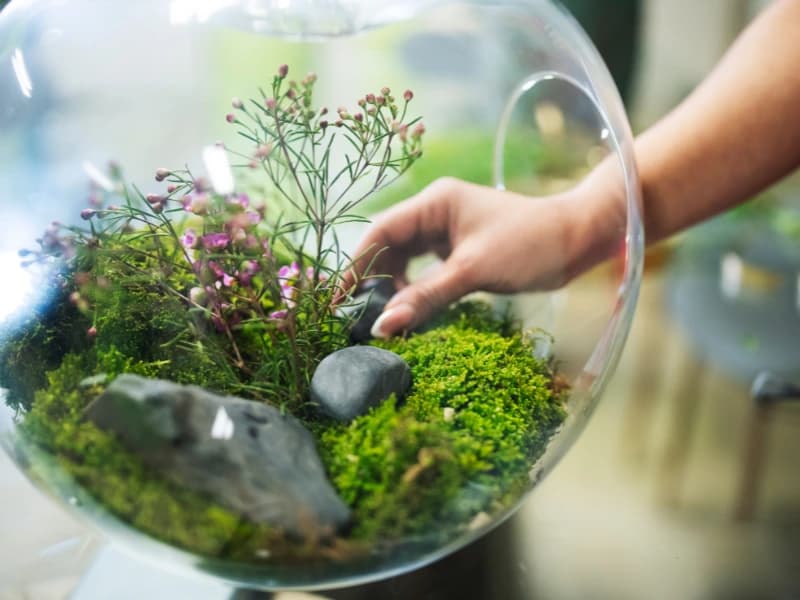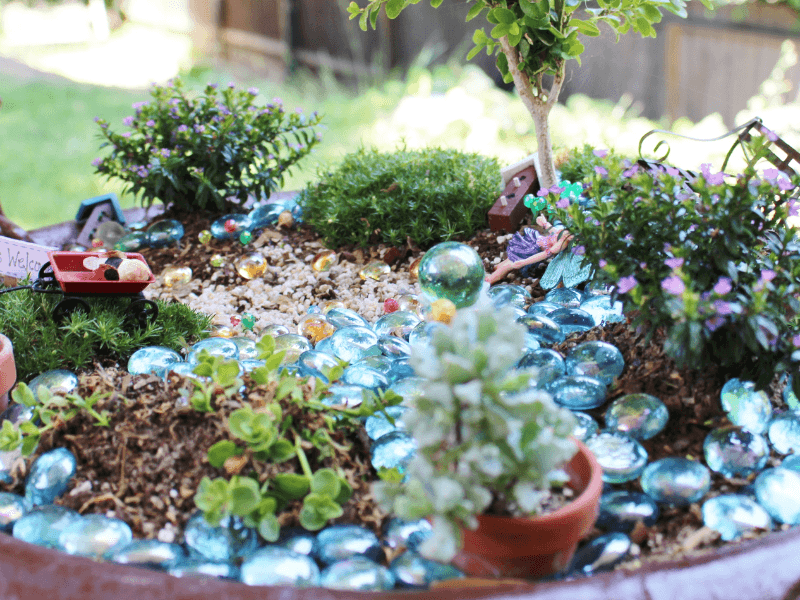Understanding the Concept of Dish Gardens
What is a Dish Garden?
Think of dish gardens like miniature landscapes: they are a kind of container gardening in which miniature landscape plants are grown in a shallow container. Dish garden setups are wildly inventive, using all manner of vessels as their container and a wondrous arrangement of plants, ornaments and other decorative elements in their design.
Historical Origins of Dish Gardens
It’s not known where exactly dish garden designs initially came from. However, these miniature landscapes are believed to have originated in Asia, primarily Japan, several hundreds of years ago. Container gardening is believed to have been an artistic hobby in Japan - which makes sense when we consider bonsai dish gardens - as well as a means of landscape architects being able to show customers their designs for larger endeavors.
Related Post: Japanese Garden Ideas
The Appeal of Miniature Landscapes
Nowadays, dish garden designs and miniature landscapes are popular for a host of different reasons. First of all, container gardening is perfect for people with small or non-existent garden spaces. They can be grown inside or outdoors and require little space or maintenance, as well as being the perfect solution to people living in places with uncertain or challenging environmental conditions.
As an indoor addition, dish gardens offer more than a regular houseplant as they can evoke and replicate an entire miniature world. Many dish garden designs center on a theme, so you can have a jungle dish garden, cactus dish garden, or succulent rosette dish garden in your home, regardless of where you live. Portable, creative, and featuring a variety of plants, dish gardens are also a great way to brighten a living space and purify the air.
Related Post: Low-Maintenance Tropical Landscape Plants

Key Components of a Dish Garden
So what’s involved in dish garden setup and how can you go about creating your own miniature landscape?
Choosing the Right Container
First of all, choosing the right vessel for your miniature landscape plants is crucial but fun as pretty much any vessel can be used for container gardening. Typically, containers are shallow with no drainage holes and a depth of two inches or more. This means, depending on the kind of dish garden design you want, you can have a mug, box, small bowl, or even a piece of driftwood as your container.
Pick a vessel that will complement the miniature landscape plants you want to use and leave enough space for your chosen plants. For example, if you want to go for a jungle dish garden, featuring taller plants, choose a container with more depth and perhaps a bright pattern or color to add to that jungle theme. A ceramic bowl, alternately, would work well for a rosette dish garden.
Selecting Suitable Plants
Once you’ve chosen your container, it’s time to choose your plants. The most important thing you need to remember when dish garden plant arrangement is that it’s vital you select plants with the same growing requirements. As they will be sharing a home, you need these plants to have the same dish garden moisture and light requirements in order to thrive. Generally, slow-growing plants for dish gardens are most popular.
Secondly, consider your dish garden plant arrangement in terms of texture and terrain and be sure to choose plants that are tall, average, and low-growing for the best effect. It’s a good idea to always use an odd number of plants in a dish garden design.
Importance of Drainage and Soil Composition
As many dish garden designs use a container with no drainage holes, you need to ensure you use various soil compositions that are properly layered to ensure your plants can thrive in the dish garden soil mix. Match the soil composition to the plants you’ve chosen. For example, a sandy soil should be used for a cactus dish garden or rosette dish garden, whereas if you’re using houseplants in a themed jungle dish garden, potting mix will work better.
Related Post: How to Care for a Cactus in Winter
Place a layer of gravel, sand, or even broken pottery or stones in the bottom of a container to help with drainage before topping up with your chosen dish garden soil mix.
Design Principles for Dish Gardens
Balancing Scale and Proportion
As miniature landscapes, dish garden designs need to be carefully planned when it comes to scale and proportion. Though you primarily want to use small and slow-growing plants for dish gardens that won’t get too big, it’s still important to use various sized, textured, colored plants to balance scale. If using a small tree in your landscape, like in a bonsai dish garden, make sure you put it in the center of the display and surround it with low-spreading plants like moss.
Creating Visual Interest and Focal Points
Approach dish garden designs like floristry. Just as a bouquet will have its focal points and filler flowers, a dish garden design should also create visual interest by using contrasting and complementary elements. Try and use the principles of flower arranging in your dish garden plant arrangement. Namely, have a “thriller” (striking plant as centerpiece), a “filler” (smaller, secondary plants that fill up space) and a “spiller” (trailing plants to cascade over the side).

Incorporating Decorative Elements
One of the best things about dish gardens is that they’re not restricted to only using plants. You can be as creative as you like with what you incorporate into your dish garden. Many people who like to make miniature landscapes will add hardscaping, ornaments and figurines to bring a dish garden setup to life.
Benefits of Having a Dish Garden
Therapeutic and Mindfulness Aspects
Similar to a Zen garden, miniature landscapes have fantastic therapeutic and mindfulness properties. The act of arranging your dish garden plants is said to be therapeutic and this kind of mindfulness and tranquility is upheld in their upkeep. Dish gardens offer a moment of recentering and pause in a busy world and are a great respite in a chaotic house or personal life.
Space-saving and Versatility
The compact and portable size of a dish garden setup means it is perfect for those in crowded living spaces. Container gardening is amazing because it can recreate the diversity and vitality of a large garden or habitat in the smallest of spaces - think of jungle dish gardens! Secondly, the versatility of these miniature landscapes is limitless, from the kind of container you use to your choice of slow-growing plants for dish gardens, to the extra decorative elements you want to include.
Enhancing Indoor Air Quality
As miniature landscapes are frequently used as indoor decoration, one of the best things about them isn’t just the aesthetic benefits they bring indoors but also their functionality. Plants are wonderful air purifiers and a dish garden design that features different plants with this purifying quality means you can enhance your indoor air quality while enjoying a truly unique centerpiece.
Common Mistakes and How to Avoid Them
Overwatering and Drainage Issues
Overwatering and ineffective draining are the most common problems with dish gardens given that they often don’t have drainage holes or the dish garden soil mix hasn’t adequately created enough drainage. To overcome this, check your dish garden moisture levels frequently by putting a finger into the soil. If it feels moist or soil clings to your finger, you don’t need to water your garden. Wait until the soil is dry and then water slowly.
Related Post: How to Water Air Plants
Overcrowding Plants
Even though you will be using slow-growing plants for your dish garden, overcrowding is still a common problem with these landscapes. Opt for fewer plants when designing your dish garden to allow adequate space for growth - you can always add more in when transplanting.
Neglecting Maintenance
Finally, while it’s true that dish gardens are generally low-maintenance, they’re not completely maintenance free and do require watering, pruning, and replanting. Checking dish garden moisture and light requirements regularly is imperative to ensuring all plants equally thrive. Don’t forget to prune as needed and watch for signs that a bigger container is needed.
That’s it! Everything you need to know about miniature landscapes and how to design your own! To get started, you can order your preferred slow-growing plants for dish gardens online with plant delivery services such as LivelyRoot and Easyplant. Go enjoy your beautiful miniature oasis!